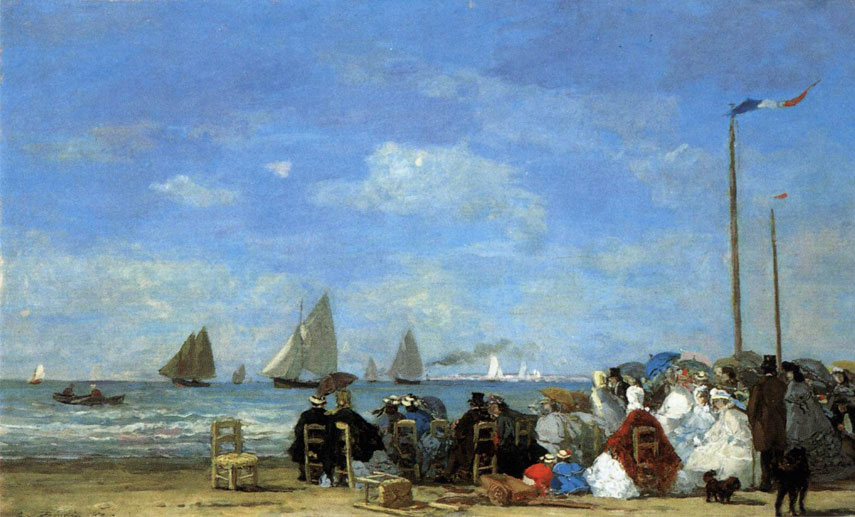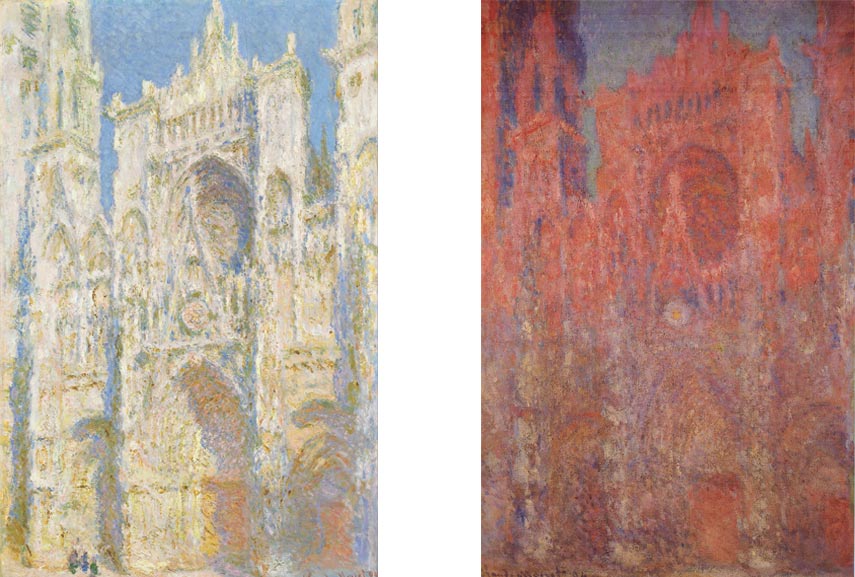The Genesis of the Impressionist Landscape
The story of the Impressionist landscape paintings is not only a tale about the use of vibrant color, or of the exploration of Nature and its shimmering light, nor is it a story only about the desire to capture the fleeting moments. Incorporating all of these, the history of the impressionist landscape paintings speaks about the rebellion and the birth of Modern Art, as well as the focus on the inner vision and the first impression of the artist. Breaking away from the art canons, firmly defined in the 16th century by the Italian Renaissance authors, Impressionism artists focused on faithfully reproducing what they saw. If the color of the lake at a certain time of the day appeared pink, the Impressionist painter would paint it pink.[1] This, of course, for the traditional paintings of the past with a clear definition of the hierarchy of subject matter and the set rules of depiction and color choices, was a fair slap in the face.
The need to capture the changing world, and to reflect on the birth of the technology which modernized the society, inspired the Impressionist artists to move outside of their studios and to start recording the modernizing world which stood before them. Relying on the changing technology and the innovation of the collapsible metal oil paint tubes, numerous artists left their studios and began painting en-plain air. Capturing not only the beauty of Nature, its beaches, and mountains, the impressionist landscape paintings introduced the original subject matter, that of the ordinary working men and of the bourgeoisie society at leisure.

Impressionism and The Push Forward – Who Inspired the Impressionist Landscape?
By the middle of the 19th-century, the method of the open-air painting was an established tradition. Even though most artists continued to maintain the distinction between oil sketches made outdoors and the finished paintings produced in the studio, a bolder production of paintings started to occur. Blurring the difference between the ideas of the rough sketch and the idealized depiction of the landscape, artists focused on depicting the ‘truths’ of the world that took them far away from the historical paintings focused on myths or allegory. These painters rebelled against the idea that painting needed to transcend the reality of the world.[2]
To the Impressionist artists, such as Claude Monet, deemed the father of the Impressionist movement, the open-air paintings of Gustave Courbet, Jean-Baptiste-Camille Corot, and Eugene Boudin were great inspirations. Almost twenty years senior to most of the Impressionists, Boudin’s creativity and approach to painting was essential for the later developments of Monet’s creativity. He was even quoted saying that three brushstrokes made outside held greater value than days spent working in the studio. His paintings, depicting beach scenes and the life of the middle-class women and men, lacked obvious narratives but focused on the essence of the certain day. Similarly, Gustave Courbet defined the rules of the past, by focusing on the production of the fresh approach to realism. His celebrated painting The Painters Studio and his many images of peasants introduced the original subject matters firmly denied entrance into the realm of paintings in the past.

Importance of The First Impression
The Impressionism movement owed its historical validity to the fact that it reflected the profound changes taking place in the whole of the European culture. As the undercurrent, which ran across Claude Monet’s paintings, there was the fresh theory of color that reflected the investigation into its perception. This was reflected in the use of vibrant colors, often straight out of the tubes, and the direct application of colors side by side instead of searching for the desired hue on the artist’s paletee.[3] Pushed forward by the desire to investigate light and its shifts, Monet’s landscape paintings are some of the most beautiful examples of the temporal changes. Often working in series, his focus on the same subject matter, as is the case with his images of Rouen Cathedral, for many marked the birth of abstraction in art. His images lacked the finished look and were the reason why the movement received the title it did. Interested in capturing the first impression of the scene before him, Monet’s approach to painting displayed the importance placed on direct observation, speed, and spontaneity. As such, the loose brushstrokes, the vibrant color choice, and the depiction of the every day became the defining trademarks of the period’s painting style.

The Later Developments Impressionist Landscapes Inspired
In his later developments, Monet started experimenting with the loose handling of the paint, bold colors and unconventional compositions which caught the attention of the pioneer abstract artist Wassily Kandinsky. Seeing his images of Haystacks, exhibited in Moscow in 1895, Kandinsky reflected that the subject matter was made known to him only with the help of the title of the work. As such, the aesthetic of the visual language of the time shared similar interests with abstract movements that followed.
The interest into the light and color inspired many of the Post-Impressionist artists. Incorporating various symbols, and the influence of the distant and primitive cultures of Oceania, as is the case with Paul Gauguin, the new paintings became arenas for change and for experimentation. The desire for the new, which the Impressionist artists called upon, also inspired the famous Pablo Picasso, whose images in return forever changed the face and the understanding of art.
To the tradition of landscape painting much is owed. In a natural setting, many authors allowed for the translation of their most inner desires, or as is the case with the Impressionism movement, of their first impressions and the scientific investigations of the day. As much as the steam of Realism painting continued and still continues to hold its ground, it is to the innovations of the major avant-garde production, contemporary art production owes its birth.
Editors’ Tip: The Art of Impressionism: Painting Technique and the Making of Modernity
From the easel painting to the mastery of the en-plain-air oil painting, the book explores the techniques of various Impressionist painters. Analyzing Monet, Pissarro, Renoir, Cézanne, Cassatt, Morisot, Caillebotte, Sisley, and Degas in the period before 1900, it places their methods and materials in a historical perspective and evaluates their origins, novelty, and meanings within the visual formation of urban modernity. The author analyzes the material constituents of oil painting and the complex processes of “making” entailed in all aspects of artistic production, discussing in particular oil painting methods for landscapists and the impact of plein air light on figure painting, studio practice, and display. Insisting that the meanings of paintings are constituted by and within the cultural matrices that produced them, Callen argues that the real “modernity” of the Impressionist enterprise lies in the painters’ material practices.
References:
- Tinterow, G., Loyrette, H., Origins of Impressionism, Metropolitan Museum of Art, 1994
- Herbert, R., L., Impressionism: Art, Leisure, and Parisian Society, Yale University Press, 1988
- Schaefer, I., von Saint-George, C., Leweremtz, K., Painting Light: The Hidden Techniques of the Impressionists, Skira, 2009
All images used for illustrative purposes only. Featured image in slider: Claude Monet - Landscape painting. Image via wallpaper.com; Claude Monet - Meule (Haystack). Image via widewalls.ch; Claude Monet - Impression, Sunrise. Image via arthistroryproject.com
Can We Help?
Have a question or a technical issue? Want to learn more about our services to art dealers? Let us know and you'll hear from us within the next 24 hours.

